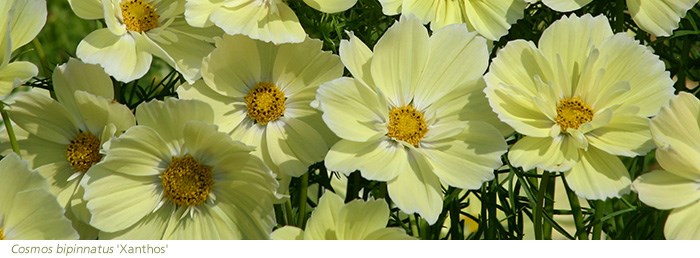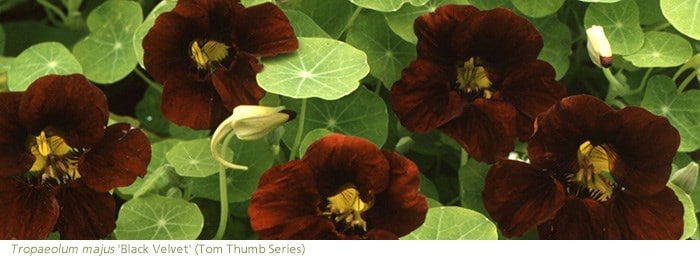Sowing half hardy annuals
If you are wanting to have a go at growing seeds then the easiest of all are the annuals because they are programmed to germinate, flower and set seed within one year - therefore they pop up easily because there’s no time to waste. Most will provide nectar and pollen aplenty, but the easily accessible single-flowered forms are best as they’re more bee-friendly.
Half hardy annuals will not survive a winter and they need warmer temperatures to germinate so are best sown in trays once Spring proper arrives. They are often indigenous to the Southern hemisphere and have a tendency to flower better in the second half of summer - once the days begin to get shorter. They can go on until late Autumn and are best sown in trays and then pricked out into individual pots. Plant them outside in early June, to avoid cold shocks, frost and the slugs. They will begin to flower by July and then just carry on.

One of the easiest is cosmos, and much plant breeding has produced many new and award-wining forms. These include the lemon-yellow ‘Xanthos’, literally Greek for yellow. It’s won a Fleuroselect Gold medal for 2016 after being trialled extensively across Europe and it’s only short, so it’s more front of border than most - or perfect for a container.
 Most cosmos come in pinks and whites though and some can be tall and imposing such as ‘Sensation Picotee’, a single white with variable dark-pink edging. If you want an easier option, ‘Razzmatazz' has fuller flowers in various shades of pink, white and violet, some with picotee edges. It’s shorter, (up to 90cm) and this is available as ready grown plugs dispatched in March.
Most cosmos come in pinks and whites though and some can be tall and imposing such as ‘Sensation Picotee’, a single white with variable dark-pink edging. If you want an easier option, ‘Razzmatazz' has fuller flowers in various shades of pink, white and violet, some with picotee edges. It’s shorter, (up to 90cm) and this is available as ready grown plugs dispatched in March.
Cosmos do well in most gardens, but Zinnia, Nicotiana and Cleome need warmth to thrive so, with our variable British summers, they are always a gamble - although one worth taking. Nicotianas have the added attraction of evening scent, designed to attract moths to their pallid flowers. The most stately, Nicotiana sylvestris, needs space to display its white candelabra of long-tubed flowers. Easier are the shorter forms such as N.‘Lime Green’, which is also a wonderful foil for darker dahlias such as ‘Karma Choc’.

Sowing seeds should be fun and there are two seeds, large and easy to handle, that children love to sow - the Nasturtium and the sunflower. Nasturtium (Tropaeolum majus) can either be sown in pots or sown straight into the ground with one proviso. Any sowing must be after the fear of frosts has passed, so early June is soon enough, because nasturtiums are blackened by the slightest frost. The trailing ‘Alaska’ will give you speckled white foliage, a cascading habit and a sunshine mixture of colourful, edible flowers. ‘Black Velvet’, a compact green-leaved form with sombre-red flowers, is another option. These lovers of poor soil will flower over many months and the large caper-like seeds will self sow, or you can collect them.
 Nasturtiums mix well with another half hardy annual, the French marigold. The red and yellow single ‘Dainty Marietta’ or the fuller-flowered mahogany-red ‘Red Safari’ have a middle that will sustain pollinators which makes them useful close to vegetables. They are also good decoy plants because their aromatic foliage attracts slugs, so it’s possible to collect them up at dusk and this protects slug-sensitive crops such as runner beans. The nasturtium is another decoy, but for cabbage white butterflies, who will often attack this before descending on your edible brassicas. Both provide a blast of sunny colour on border edges.
Nasturtiums mix well with another half hardy annual, the French marigold. The red and yellow single ‘Dainty Marietta’ or the fuller-flowered mahogany-red ‘Red Safari’ have a middle that will sustain pollinators which makes them useful close to vegetables. They are also good decoy plants because their aromatic foliage attracts slugs, so it’s possible to collect them up at dusk and this protects slug-sensitive crops such as runner beans. The nasturtium is another decoy, but for cabbage white butterflies, who will often attack this before descending on your edible brassicas. Both provide a blast of sunny colour on border edges.







